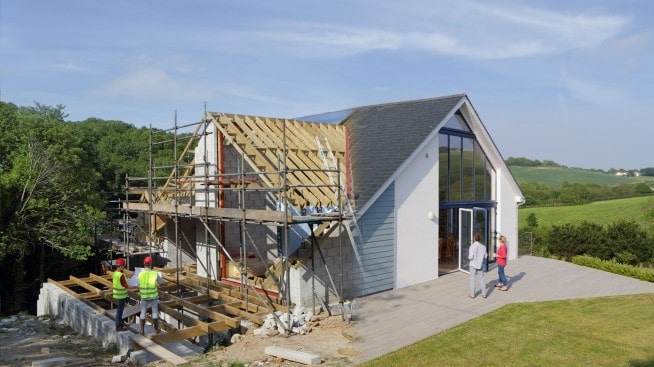What to know about multi-family homes

If you’re looking to start investing in real estate but aren’t quite sure how, multi-family homes may be a good place to begin. But before making any investment, you’ll want to learn as much as you can. Put simply, multi-family homes are housing units meant for more than one family — you can probably picture a multi-family home right now. They come in all different shapes and sizes.
Let’s take a deeper look at multi-family homes, including the different types of homes you’ll find, the pros and cons of investing in one and how you might go about financing your project.
Note: The definitions of multi-family homes and the different types may vary depending on your lender, who you’re purchasing the property from and what mortgage product you’re using to finance your purchase.
What is a multi-family home?
A multi-family home is also known as a multi-dwelling unit. It can accommodate more than one family or individual living separately. It may be a duplex, which has two units, or contain several apartments. Typically, anything with more than four units goes from a multi-family unit (that can be purchased with a traditional mortgage) to a commercial property (that can be purchased with a commercial mortgage).
As of 2019, multifamily homes accounted for approximately 43.9 million residences, or 31.4% of housing in the U.S. according to a survey conducted by the American Housing Survey and the U.S. Census Bureau. As mentioned, there are different types of multi-family homes:
Duplex
A duplex is a multi-family unit with two separate dwellings in one property. Some duplexes have one front door with separate entrances to each unit within the property, while other duplexes may have a single structure with two separate entrances. Each unit is typically considered a “duplex apartment.” Oftentimes, a duplex will look like a single-family home. Typically, a duplex has one unit stacked on top of another.
In major cities, a "duplex" might sometimes refer to a single dwelling unit that spans two floors within a larger building; however, this is different from the more popular definition of a multi-family duplex, which typically consists of two separate dwelling units within the same building.
Apartment building
An apartment building is a multi-story residence containing multiple units for rent. The difference between an apartment building and a condo or co-op is that the individual units are not owned separately. Typically, one entity owns the building and rents out each individual unit. Depending on the size of the apartment building, it may be considered “commercial real estate” and affect how you’d finance the purchase.
What isn’t a multi-family home?
It’s easy to assume that a grouping of multiple dwelling units likely constitutes a multi-family home. However, this isn’t always the case. Some property types that are often mistaken as multi-family homes but aren’t include:
Townhouse or townhome
A common misconception is that a townhouse is a multi-family home — a townhouse is a single-family home, often located in a complex of other townhouses, that shares one or multiple walls with other attached homes. Although these units are typically side by side and separated only by an interior wall, they are deeded separately and have different owners. Therefore, townhouses are not considered multi-family homes. They often offer more space than duplexes and typically feel more like a single-family home once inside the unit.
Semi-detached homes
Semi-detached homes are commonly conflated with multi-family homes. While a semi-detached home shares a wall with another home, similar to a townhouse, it is typically only one wall or a small part of the home that's attached to another. Unlike multi-family homes, which may comprise several units within a single property, semi-detached homes are deeded separately and are usually owned by two different parties. Thus, they are more akin to single-family homes than multi-family homes.
Pros and cons of investing in multi-family homes
As you embark on your first venture investing in a multi-family home, there are pros and cons worth considering:
Pros of investing in a multi-family home
- Opportunity for multiple streams of passive income: Rather than buying a single-family home, renting it out and getting one source of income, a multi-family home gives you the opportunity for multiple streams of passive income. Do note that the cost of your mortgage payment may offset some (or possibly most) of your passive income until the mortgage is paid off.
- Scalability: Investing in a multi-family home can both scale and diversify your investment property portfolio faster than if you were to invest in a single-family home. You’re essentially killing two birds with one stone by making one purchase with multiple units and therefore, multiple opportunities for income.
- Potential tax write-offs and expensing: Operating your property as a business may open the door to tax benefits through writing off repairs, interest paid on your mortgage and other business operating expenses. It’s best practice to consult a tax professional before making any decisions to see how your state’s tax policies might affect your property in this scenario.
Cons of investing in a multi-family home
- Managing multiple units: If you invest in a multi-family home, this means you‘re also committing to the responsibility of managing multiple units. You may opt to hire a property manager, which can be helpful when it comes to handing off responsibilities, but this will come at a cost.
- Dealing with potential liability issues: From a statistical standpoint, multiplying the amount of units you own multiplies potential liability issues. You’ll want to ensure your building is up to code and your insurance policy is adequate in the event of an emergency.
- Responsible for covering the costs of multiple units: Owning multiple units is both a pro and a con. It’s a pro because you have multiple streams of income, but it can also be a con in a down market or if your tenants stop making payments. It’s best practice to have a nest egg for these scenarios so you can comfortably pay your mortgage and utilities in the absence of rental income.
How to finance multi-family homes
Many multi-family homes can be financed with a traditional mortgage, but some larger multi-family homes may require a different mortgage product. For example, if you’re buying a duplex, triplex or fourplex, you’ll likely be able to finance your purchase with a traditional loan. On the other hand, if you’re buying a larger apartment building, you may need a commercial loan — depending on its size, the building may be considered a commercial property instead of a multi-family residence.
In summary
Multi-family homes are properties with more than one dwelling where separate individuals or families can reside. Duplexes and apartment buildings are common examples of multi-family homes. Investing in a multi-family home gives you the opportunity to have multiple streams of income, as opposed to investing in a single-family home. Before investing in a multi-family home, be sure to investigate your mortgage options and how much responsibility you’re prepared to take on.



